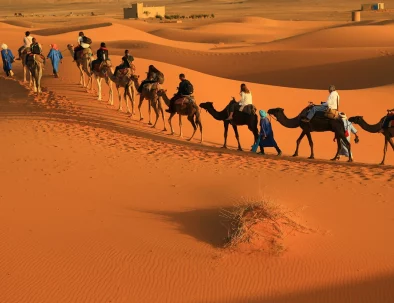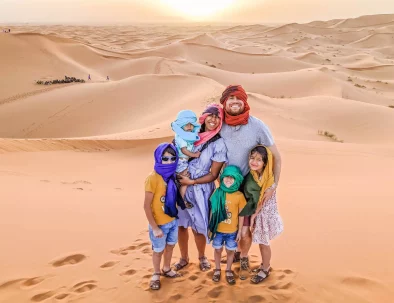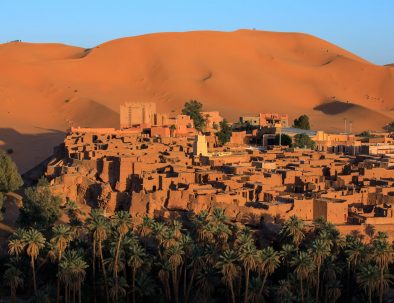Day 1: Tangier and the Blue City of Chefchaouen
Welcome to Tangier, the nexus of Africa and Europe! Visit the medina (old quarter), a café in the trendy Zoco Chico square, or go for a paseo to enjoy a stroll along the promenade in this city close to the south of Spain. The blue-hued city of Chefchaouen in the Rif Mountains is another option. Enjoy the scenic route and make stops to hike to the Cascades d’Akhour along the way (Waterfalls of Akchour). Chefchaoen offers countless winding, small streets, as well as beautiful structures. Discover a restaurant or café in Plaza Outa el Hammam and eat while people-watching.
The Grand Mosque is still worthwhile a visit even though non-Muslims are not allowed inside. Discover the garden, museum, and prison cells of the nearby kasbah, an ancient fortification. A path outside the city walls will lead you to Hotel Atlas, where you can climb to the rooftop for a sweeping view of Blue City. For those who are a little fitter, follow the road east, cross the Ras el Ma Spring, and then climb the path for 20 to 30 minutes until you reach the deserted white Spanish Mosque. Observe Chefchaouen one last time as the sun sets behind the mountains.
2 to 3 hours for the hike
Day 2: Roman Ruins of Volubilis and the imperial cities of Meknes and Fes
Before leaving for Fes, get up early to take pictures of the deserted streets. Stop off en route at the Volubilis ruins, the Roman Empire’s furthest outpost in Africa, protected by UNESCO. Wander the complex and discover the temples, many in-place mosaics, and merchant homes with still-working heating systems. Continue to Meknes, a less crowded, smaller version of Fes, for an introduction to a former imperial city. The main attractions are the Ville Impériale (Imperial City) and the medina. Visit the Royal Stables, the Moulay Ismail Mausoleum, and Bab al-Mansour Gate.
Proceed to Fes, your second imperial city. Fes is a city worth getting lost in because of its imposingly sizable (and occasionally perplexing) old medina. Spend some time at the Merenid Tombs to the north of the city to take in the expansive views of old Fes and the region before going into the medina. Return to your riad (a traditional Moroccan home with an interior garden) for the evening as you descend the hill.Your guide will then escort you through Marrakech’s bustling souks, where you can meet various artisans and learn about their wares. By mid-afternoon, your tour will be over, and you’ll have the rest of the day to explore independently. Visit the souks to buy trinkets, enjoy a delicious traditional meal in one of Marrakech’s restaurants, or wander the Jemaa el-Fna square’s stalls to chow down on mouthwatering street fare while taking in the crowds’ entertainment from musicians and snake charmers.
Day 3: Fes: Exploring the Imperial City and medieval Medina
Marrakech and Rabat are the other two Moroccan imperial cities; Fes is the oldest and, arguably, the most fascinating to explore. The city, a UNESCO-protected site, has yet to undergo much colonial development, so you can still enjoy its medieval charm. Fes comprises the early 20th-century French-designed Ville Nouvelle and two old medina quarters, Fes el Bali (where you will spend most of your time) and Fes el Jdid (a slightly newer area of the city). Beginning in Fes el Bali, meet your guide, who will assist you in navigating the winding, ancient streets of the medinas (789 CE).
As you pass the various souks (markets) selling spices, leather goods, and pewter, take note of the Spanish and Tunisian-inspired architecture. Visit the well-known Chouara Tannery and climb to the roof of a nearby store for a better view of the action in this region, which is known for its tanneries and the pungent smell they produce. Visit the 14th-century Al Attarine Madrasa and marvel at the zellij tilework before visiting Al-Qarawiyyin University, one of the oldest still in operation universities in the world (859 CE). Another expansive view of the city can be found by visiting the mellah (old Jewish quarter) in Fes el Jdid.
After exploring the lovely settlement and eating lunch, we set out for today’s ultimate destination: Demnate. Take a stroll around the natural bridge Imi n’Ifri before turning in for the evening.
Day 4: Fes to Casablanca via Rabat
Travel to Rabat, the modern capital of Morocco, which was once an imperial city. Wander the Roman and Islamic ruins while exploring the Chellah Necropolis’ medieval fortification. Enter the old city of Rabat through the majestic door of the Kasbah des Oudaias. Visit the 20th-century Andalusian Gardens from there to take in the tranquil setting away from the crowds. Learn about the Hassan Tower, a minaret of the unfinished Mosque, and the Mohamed V mausoleum. The tower and about 200 columns are all that is left of a 12th-century project that was abandoned.
Until you reach Casablanca, keep traveling south along the Atlantic coast. Walk to the Hassan II Mosque along the Boulevard de la Corniche, the beach promenade that follows the Atlantic (often referred to as Morocco’s Miami). Even though there are only morning interior tours available, take advantage of the time and observe the architectural wonder as the sun sets. Grab a bite at Rick’s Café, a restaurant, bar, and café built to look like the bar in the Casablanca movie.
Day 5: Casablanca to Marrakech
The magnificent Hassan II Mosque can be found in Casablanca, which serves as Morocco’s modern commercial capital. It is the tallest building in Morocco and has the tallest minaret in the world, standing at 690 feet (210 meters) above the Atlantic. An estimated 80,000 worshipers could fit in the interior, according to estimates. Being one of the few mosques in the nation where non-Muslims are permitted to enter makes this Mosque special. Join a morning tour to see the incredibly detailed craftsmanship: Detailed marble floors, hand-carved stone, and ceilings made of gilded cedar.
Arrive in vibrant Marrakech late afternoon or early evening, then check into your riad and start exploring. Get on a calèche (French for horse-drawn carriage) and get your bearings for a distinctive way to explore the medina. The main square, Jemaa el-Fna, comes alive in the early evening with musicians, performers, snake charmers, games, and food stalls, offering a variety of entertainment. Choose one of the many cafés surrounding the square and take in a meal and a cup of mint tea if you want to observe the spectacle from a distance.
Day 6: Marrakech: Exploring the Red City
The magnificent Hassan II Mosque can be found in Casablanca, which serves as Morocco’s modern commercial capital. It is the tallest building in Morocco and has the tallest minaret in the world, standing at 690 feet (210 meters) above the Atlantic. An estimated 80,000 worshipers could fit in the interior, according to estimates. Being one of the few mosques in the nation where non-Muslims are permitted to enter makes this Mosque special. Join a morning tour to see the incredibly detailed craftsmanship: Detailed marble floors, hand-carved stone, and ceilings made of gilded cedar.
Arrive in vibrant Marrakech late afternoon or early evening, then check into your riad and start exploring. Get on a calèche (French for horse-drawn carriage) and get your bearings for a distinctive way to explore the medina. The main square, Jemaa el-Fna, comes alive in the early evening with musicians, performers, snake charmers, games, and food stalls, offering a variety of entertainment. Choose one of the many cafés surrounding the square and take in a meal and a cup of mint tea if you want to observe the spectacle from a distance.
Day 6:
Marrakech, also known as the “Red City” due to its red sandstone walls and buildings, was once an important trading center for the tribes of the Atlas Mountains and is still a fascinating former imperial city. Start your exploration of Marrakech’s historic medina at the Koutoubia Mosque and Gardens. The Mosque’s 253-foot (77-meter) minaret and 12th-century foundations are worth seeing even though non-Muslims are not permitted inside. Visit the adjacent garden’s fountains and pools.
center for the tribes of the Atlas Mountains and is still a fascinating former imperial city. Start your exploration of Marrakech’s historic medina at the Koutoubia Mosque and Gardens. The Mosque’s 253-foot (77-meter) minaret and 12th-century foundations are worth seeing even though non-Muslims are not permitted inside. Visit the adjacent garden’s fountains and pools.
Explore the intricate maze of souks hidden behind regular restaurants and shops while indulging your senses. You can find a variety of spices, woodwork, and babouche at Souk el Attarin, Souk Chouari, and Souk Smita (traditional Moroccan slippers). To look at how cloth and yarn are dyed using conventional techniques, visit the Souk des Teinturiers or the dyers’ souk. The Ben Youssef Madrasa, a 16th-century Koranic school, is a fine example of Moroccan Islamic architecture. Pay attention to the elaborate interior decoration, which includes carved cedar ceilings, plaster sculptures, and zellij tiling.
Day 7: Amizmiz and the High Atlas mountains
Today, you’ll travel south of Marrakech to the tiny town of Amizmiz in the High Atlas mountain foothills (about one hour away). Before joining your mountain guide for a trek along the winding roads and mule paths in the nearby hills, spend some time exploring the small market in the old town. Observe the local farmers and shepherds as they tend to their flocks and the surrounding landscape as you hike between small Berber villages. You might even see kids on their way to or from school, typically shared by a few nearby villages.
As you learn how to make homemade bread, stop to have lunch with a local family and gain insight into their way of life. After hiking through the afternoon, return to a different local Berber home, where you will be welcomed for dinner and given room to rest for the evening.
Day 8: Continue Hiking; Return to Marrakech
Have breakfast with your hosts before bidding them farewell and beginning your hike. Before returning to Marrakech, continue exploring the local area’s landscape and other nearby towns.
When you get to Marrakech, check out the Saadian Tombs, the area south of Jemaa el-Fna, and learn about the 500-year-old craftsmanship that went into its building. As you proceed through the mellah (Jewish quarter) to the 19th-century Bahia Palace, stop by the sunken gardens of the 17th-century El Badi Palace. You can view displays of clothing, antiques, jewelry, and exquisitely carved Hispano-Moorish decorations of carved cedar wood at the Dar Di Said Museum (also known as the Museum of Moroccan Arts) if you have time.
Day 9: Departure from Marrakech
Get up early and finish any last-minute souvenir and gift shopping before locating the Almoravid Koubba from the 12th century. The Koubba, the sole remaining Almoravid structure, was rediscovered in 1948. Visit the Marrakech Museum if time permits. The museum offers a collection of contemporary and traditional artwork that includes items from the Berber, Moroccan, Jewish, and Islamic cultures. It has been housed in the Moorish Dar Mnebbi Palace since the 19th century.



